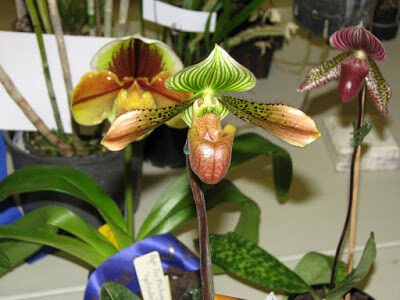Several species of this orchid, particularly Paphiopedilum callosum and P. sukhakulii, and some of the smaller hybrids will do well in a living room, preferably near a window that does not receive too much sunlight. Wherever slipper orchids are sited, they require plenty of humidity as well as good ventilation during the hotter months.

Paphiopedilums do not require a dormant Paphiopedilum season, but if the temperature drops in winter, the water supply must be decreased. The blooms of these popular orchids have a striking sepal, usually called the flag; the lip of the flower is called the “slipper” because its pouch-like shape resembles a house slipper. Many hybrids are available from specialist suppliers, and new ones are being added constantly.
FACT FILE Paphiopedilum spp. Orchidaceae LADY’SSlipper orchids

ORIGIN: Tropical Asia; hybrids.
HEIGHT: 15in/38cm.
POTTING MIX: Special orchid medium.
REPOTTING: Repot annually in late winter. Always provide excellent drainage in the bottom of the pot. P. callosum should be kept completely dry for a few weeks after being repotted.
PROPAGATION: Divide when repotting.
KEEPING PLANTS: High humidity (65-75%) and a daytime temperature some 9°F/5°C above the night temperature are needed.
PLANT CARE Paphiopedilum spp. Orchidaceae LADY’SSlipper orchids
- Bright light, but the full sun only in winter.
- Normal room temperature, but not below 65°F/18°C at night.
- Water once a week throughout the year.

- Spray the plant daily and stand the pot on a tray of moist gravel to maintain humidity.
- Never allow water to lie on the leaves or in the center of the growth; this will encourage botrytis and cause the plant to rot.
- Apply a weak foliar feed once a month from spring to fall.
- Share
- Share
- Share
- Share
